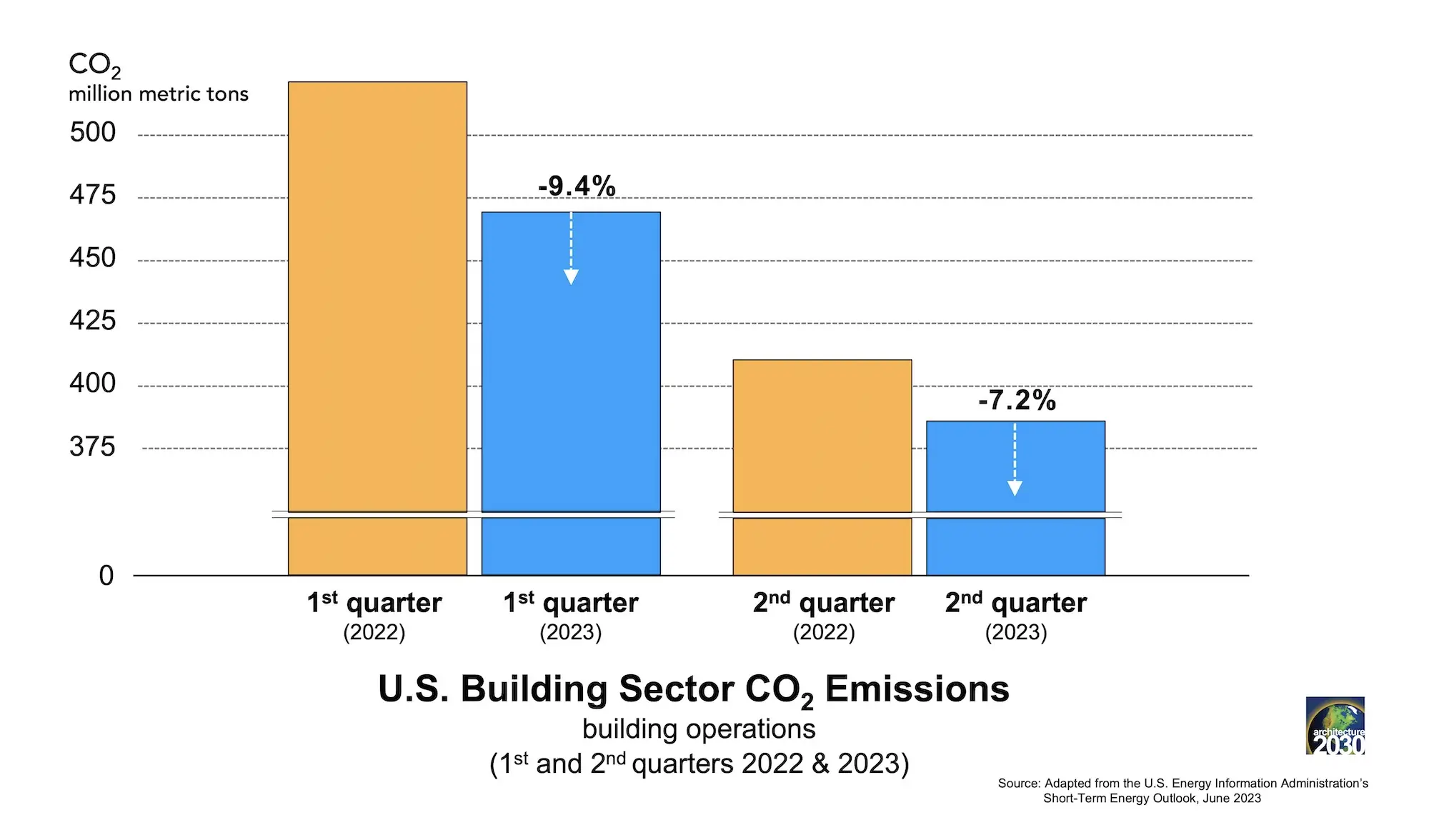According to U.S. Energy Information Administration (EIA) statistics, U.S. building sector operating emissions fell in the first half of 2023 by about 8.4 percent percent, or 78.8 million metric tons CO2, compared to the same time last year.

Image courtesy Architecture 2030
This fact is astonishing considering we added roughly 4 billion square feet to our building stock during that period according to the EIA. By contrast, we have been reducing emissions by an average of only 1.9 percent annually since 2005.
What is responsible for this emissions reduction?
First, building sector electricity and natural gas consumption were lower compared to the same time last year (by 2.8 percent and 6.7 percent respectively) and solar installations were the leading source of new U.S. electricity generation during this period. However, the greatest emissions reduction resulted from a drop in coal-generated electricity, which declined an unprecedented 29 percent during that period. Coal-fired electricity generation is expected to continue to decline throughout the year as renewable fuel sources continue to increase. Since more than 70 percent of the energy used in buildings is electricity, cleaner onsite and off-site generation equals less building emissions.
Further, it is estimated that the Infrastructure Law of 2021 and Inflation Reduction Act of 2022, which include incentives for and investments in solar, wind, building-integrated renewable energy technologies, and efficiency measures, will help lower grid emissions to 68-78 precent below 2005 levels by 2030. This will put a zero emissions grid by 2035 within reach.
Transitioning to renewable generation and electrifying buildings and other end uses will bring about significant additional benefits– improved air quality, zero electricity generation fuel costs, and energy price stability. Improved air quality alone would help prevent up to 130,000 premature deaths in the coming decades. When factoring in reduced mortality costs, with potential reductions in damage from floods, drought, wildfires, and hurricanes due to climate change, the United States could save from $920 billion to $1.2 trillion by 2035.
Globally, a major development is also underway as the energy transition to renewables is now proceeding at an accelerated pace. Solar and wind power are growing exponentially, and renewables are expected to overtake fossil fuels and become the world’s largest source of electricity generation within the next two years.
While much progress has been made in advancing electrification and zero emissions buildings (operating and embodied carbon), we must now unlock the enormous creative potential of the architecture, planning, and design community to broaden our efforts beyond buildings by addressing the entire built environment. Often overlooked, the exterior built environment presents vast areas where emissions reductions and carbon sequestration can be implemented.

Image courtesy Architecture 2030
With 75 percent of the global infrastructure that will exist in 2050 yet to be built, we have a unique opportunity to plan and design exterior built environments that are carbon positive, resource efficient, and resilient. Specific climate positive design approaches range broadly from bio-based and carbon sequestering materials to urban afforestation, habitat restoration and creation, constructed wetlands, agrivoltaics and urban agriculture, 15-minute and sponge cities, nature-based infrastructure, carbon sequestering sites, habitat corridors and living shorelines.
By "future-proofing" our infrastructure, we can reap numerous additional benefits and address pressing environmental challenges that include promising protection from the adverse effects of climate change such as sea-level rise, floods, drought, urban heat-islands, and wildfires.
Addressing climate change and the entire built environment begins with design. We’ve taken the initiative to lead, now the work intensifies as we expand our scope, influence, and impact.






Post a comment to this article
Report Abusive Comment